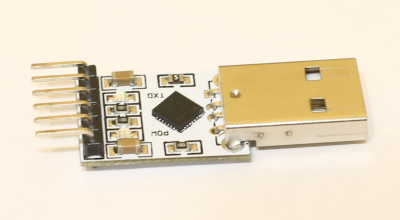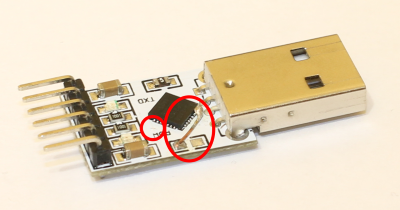Modification of the USB-UART converter on the CP2102 chip for use as an Arduino programmer
This method requires direct hands of nanobots - use the described at your own risk.
I got a USB-UART converter on the CP2102 chip that came bundled with the Arduino Pro Mini and claimed to be a programmer for it:

When I connected to the Arduino and tried to fill in the sketch, I found that the fill was not happening. An error is
generated : avrdude: stk500_getsync (): not in sync: resp = 0x00 The
search answered the question why this is happening. It turned out that the RST at the output of the programmer was routed in such a way that it is a digital input and is designed to reset the CP2102 chip by a signal from an external device, rather than resetting the external device itself. Further searches led to an article describing how to fix this.
In the article, I did not like the fact that a separate wire is soldered to the chip. I wanted to try using the existing RST output. Having a little understanding of the topology of the board, I found that the track from the RST pin through a through vias hole is connected to one of the legs of the CP2102 chip and the resistance on the front side of the board.
Thus, it is necessary to cut the portion of the track between the vias and pin CP2102, as well as to remove the SMD resistor above the inscription POW (the inscription “1001” on the resistor). Next, you need to connect the terminal CP2102 "DTR" with the wire and the contact pad remaining after the resistor is soldered, located closer to the POW inscription. This will connect the DTR pin to the RST board pin.
Armed with a breadboard knife and a soldering iron, I set to work. The result was such a miracle of technology: The

circle on the left marks the cut path, and the oval on the right is a piece of soldered wire. In order for the terminals of the microcircuit to stick together from tin, pour this side of the microcircuit with an alcohol-rosin mixture. Alcohol will quickly evaporate, however, when soldering, rosin boiling under the sting will not allow tin to solder legs together (of course, if you do not overdo it with tin).
Next, you should check the functionality of the resulting board using the RealTerm program . Open the “Pins” tab - setting and resetting the DTR pin should not affect the operation of the DSR pin, but it should control the voltage at the output of the RST board.
When all checks are completed, you can try to fill in the sketch. We connect the Arduino Pro Mini to the converter:
(Converter) <-> (Arduino)
RST <-> DTR
TXD <-> RXD
RXD <-> TXD
GND <-> GND
5V <-> VCC
Now my sketch was uploaded successfully.
I hope you succeed!
I got a USB-UART converter on the CP2102 chip that came bundled with the Arduino Pro Mini and claimed to be a programmer for it:

When I connected to the Arduino and tried to fill in the sketch, I found that the fill was not happening. An error is
generated : avrdude: stk500_getsync (): not in sync: resp = 0x00 The
search answered the question why this is happening. It turned out that the RST at the output of the programmer was routed in such a way that it is a digital input and is designed to reset the CP2102 chip by a signal from an external device, rather than resetting the external device itself. Further searches led to an article describing how to fix this.
In the article, I did not like the fact that a separate wire is soldered to the chip. I wanted to try using the existing RST output. Having a little understanding of the topology of the board, I found that the track from the RST pin through a through vias hole is connected to one of the legs of the CP2102 chip and the resistance on the front side of the board.
Thus, it is necessary to cut the portion of the track between the vias and pin CP2102, as well as to remove the SMD resistor above the inscription POW (the inscription “1001” on the resistor). Next, you need to connect the terminal CP2102 "DTR" with the wire and the contact pad remaining after the resistor is soldered, located closer to the POW inscription. This will connect the DTR pin to the RST board pin.
Armed with a breadboard knife and a soldering iron, I set to work. The result was such a miracle of technology: The

circle on the left marks the cut path, and the oval on the right is a piece of soldered wire. In order for the terminals of the microcircuit to stick together from tin, pour this side of the microcircuit with an alcohol-rosin mixture. Alcohol will quickly evaporate, however, when soldering, rosin boiling under the sting will not allow tin to solder legs together (of course, if you do not overdo it with tin).
Next, you should check the functionality of the resulting board using the RealTerm program . Open the “Pins” tab - setting and resetting the DTR pin should not affect the operation of the DSR pin, but it should control the voltage at the output of the RST board.
When all checks are completed, you can try to fill in the sketch. We connect the Arduino Pro Mini to the converter:
(Converter) <-> (Arduino)
RST <-> DTR
TXD <-> RXD
RXD <-> TXD
GND <-> GND
5V <-> VCC
Now my sketch was uploaded successfully.
I hope you succeed!
